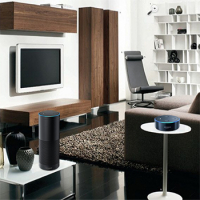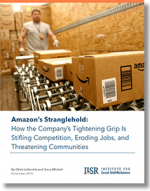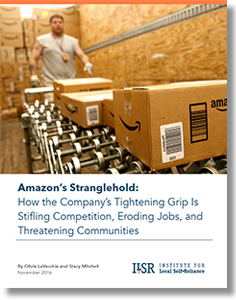Amazon’s Stranglehold
This report aims to pull back Amazon’s cloak of invisibility, it shows how the company’s tightening grip is stifling competition, eroding jobs, and threatening communities - it presents new data; draws on interviews with dozens of manufacturers, retailers, and others; and synthesizes a broad body of previous reporting and scholarship.
There are tells, but only if you’re looking for them.
There might be a package on a doorstep, or a pile of boxes outside on recycling day, or a white truck with an unassuming black “A” and an orange arrow underneath stopped at a red light.
At coffee shops or libraries, you can see glimpses of the logo on people’s computer screens, and if you drive to the industrial office parks on the outskirts of cities, near freight hubs and airports, you can find the warehouses, low-slung and sprawling.
For all of its reach, Amazon, the company founded by Jeff Bezos in 1995 as an online bookstore, is still remarkably invisible.
It makes it easy not to notice how powerful and wide-ranging it has become.
But behind the packages on the doorstep, and behind the inviting interface and seamless service that has consistently put the company at the top of corporate reputation
rankings,1 Amazon has quietly positioned itself at the center of a growing share of our daily activities and transactions, extending its tentacles across our economy, and with it, our lives.
Today, half of all U.S. households are subscribed to the membership program Amazon Prime, half of all online shopping searches start directly on Amazon, and Amazon captures nearly one in every two dollars that Americans spend online.
Amazon sells more books, toys, and by next year, apparel and consumer electronics than any retailer online or off, and is investing heavily in its grocery business.
As a retailer, its market power now rivals or exceeds that of Walmart, and it stands only to grow: Within five years, one-fifth of the U.S.’s $3.6 trillion retail market will have shifted online, and Amazon is on track to capture two-thirds of that share.
But describing Amazon’s reach in the retail sector describes only one of the company’s tentacles. Amazon is far more than a big, aggressive retailer.
The company is a novel kind of power, a power that, as New Yorker writer George Packer has described, is “something new in the history of American business.”
As we show in this report, Amazon increasingly controls the underlying infrastructure of the economy. Its Marketplace for thirdparty sellers has become the dominant platform for digital commerce.
Its Amazon Web Services division provides the cloud computing backbone for much of the country, powering everyone from Netflix to the CIA.
Its distribution network includes warehouses and delivery stations in nearly every major U.S. city, and it’s rapidly moving into shipping and package delivery for both itself and others.
By controlling this critical infrastructure, Amazon both competes with other companies and sets the terms by which these same rivals can reach the market.
What’s Related



Favorites





